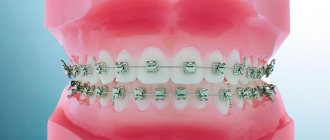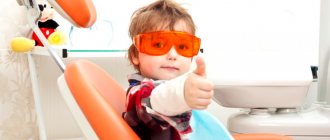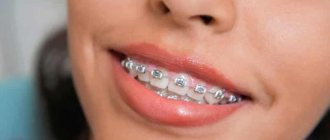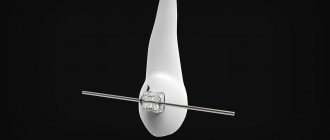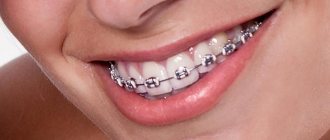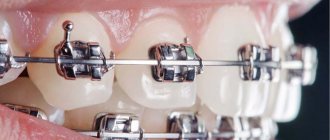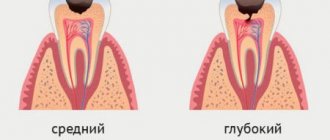The effectiveness of orthodontic correction of defects of the dental system directly depends on the age of the patient. It is considered optimal to carry out treatment in children at the stage of mixed and emerging permanent dentition. In this regard, correction of dentition defects is one of the most important areas of pediatric dentistry.
If the time for wearing plates is missed, braces can be used in children. For some reason, it is believed that this orthodontic structure cannot be used until adolescence. At the same time, it is in children that the bite problem can be solved most simply and quickly, without waiting for crooked teeth to become “overgrown” with complexes, a feeling of insecurity about one’s own attractiveness and problems in interpersonal communication.
The principle of operation of the braces system
Orthodontic construction, widely used to give teeth the correct position in the jaw, consists of a number of individual elements. First of all, these are clasps that are attached to the enamel surface. They are united into a single system by a force arc - a thick wire that creates the necessary pressure on the teeth.
Braces (clasps), individual elements with special grooves or clips for wires, are necessary to fix the structure on the teeth. Most often they are made of metal, but there may be other options. The clasps are held on the surface of the tooth using a special dental adhesive.
Dental wire is no different in appearance from ordinary metal wire and is gray in color. In expensive orthodontic systems, which are almost invisible on the teeth, white wire may be used. A feature of the arc is “shape memory”. Initially, it has a configuration that corresponds to an ideal bite. When the wire is deformed by the doctor during the installation of the system, it tends to return to its original position, pulls the clasps with it and thus helps correct the position of the teeth.
General presentation and design features
The braces system is a non-removable corrective device designed to correct malocclusions and dentition. The main element of the structure, fixed on the vestibular or inner surface of the teeth, is the expanding arch. The metal used for its manufacture does not cause an allergic reaction, and has shape memory, which determines the constant desire of the arc element to regain its original structure. The constant action of force applied to the jaw arch is the main factor due to which children's braces correct the position of individual elements of the dentition, straighten the bite and restore the muscle tone necessary to maintain correct occlusion.
Features of the children's braces system
Nowadays, orthodontic treatment can be performed on patients of all ages. Dentists actively encourage adults to correct their bite. At the same time, children and adolescents with crooked teeth, for whom the optimal period for correcting dentoalveolar anomalies has arrived, fade into the background. From 12 to 18 years of age, active formation of the jaws occurs, the tissues are flexible, and the teeth respond well to the pressure exerted on them. You can achieve the desired result with the least effort. However, for some reason many adults believe that “the child will outgrow it” and “the teeth will straighten out on their own.”
Up to 12 years of age, during the period of mixed dentition, orthodontic correction can also be carried out. However, the bracket system cannot be used for this purpose, since during this period the pressure of the structure is excessive. It is more advisable to use plates and other orthodontic devices that have a softer and more gentle effect on the dental system.
The age for starting orthodontic correction using a brace system at 12 years is indicated very arbitrarily. The development of children is uneven, so the orthodontist must take into account the individual characteristics of the young patient when determining the indications for starting treatment. The specialist’s decision is based on data from a dental examination and x-ray examination. In fact, the child undergoes the entire range of diagnostic tests that are necessary for an adult patient in the same situation. However, the objectives of the examination differ, just like the algorithms for determining indications and contraindications for treatment.
Children's braces, in addition to a special approach to installation, differ from adults in a shorter wearing period. However, the cost of orthodontic correction in children and adolescents may exceed that in adults.
How long does a child need to wear braces?
The duration of treatment depends on the age of the child and the intensity of the problem. Minor distortions can be corrected in a few months, and serious violations can be corrected in 1–2 years. Rarely do children have to wear braces for longer than 1 year.
The brand of braces also affects the duration of treatment. For example, the manufacturer Damon uses technology to reduce the treatment period by several months, even for adults. The doctor will determine the approximate period during consultation after selecting suitable designs.
Types of children's braces
A fairly large number of modifications of brace systems have been developed and are used, which differ from each other in the location of the structure in the oral cavity and the material from which the clasps are made. Most types of systems can be successfully used in patients of all ages, starting from 12 years of age.
Ways to arrange the structure
Most often in the practice of an orthodontist, vestibular corrective structures are used. Vestibular clasps are attached to the outer surface of the dental crown. Such a device is much easier to install, adjust, and clean from plaque and food debris. Obvious shortcomings include the unaesthetic appearance of the system, which is visible when smiling and during a conversation.
Lingual braces, which are installed on the lingual surface of the teeth, are completely invisible to others and are just as effective as vestibular braces. However, they are made individually from gold and other expensive metals, which determines the high price of the structure. A system for one jaw can cost a patient 120 thousand rubles or more. The system also significantly reduces the oral cavity and limits the movement of the tongue, which affects diction.
For children and adolescents, the aesthetic side of the issue of orthodontic correction is very acute. Any comments or non-verbal signs of disapproval from peers regarding “braces on the teeth” may lead to refusal to continue treatment.
When is it necessary to bring a child to an orthodontist?
Let’s look at when a teenager needs braces:
- Large gaps between teeth (trema and diastema);
- Crowded teeth (severe lack of space);
- Untimely tooth loss;
- Various bite pathologies: distal, mesial, open, deep or crossbite.
Ligature and self-ligating systems
Ligatures are additional elements of the bracket system that hold the arch in the groove of the lock. At the initial stage of treatment, pieces of thin wire are used as ligatures. Then they are replaced with elastic bands. The main purpose of the ligatures is to ensure the movement of the clasps following the changing shape of the arch. The wire fixes the braces very tightly, which often leads to uneven load on the teeth. In this regard, aching pain may appear that an adult, let alone a child, can hardly endure. Rubber bands are stained with pigments from food and drinks, which requires their regular replacement.
In self-ligating systems, the clasps have a special clip that secures the arch. The connection using a clip is not as rigid as using a wire ligature. As the teeth shift, the clasps can move within a small range relative to the power arc, which allows the load on the dental system to be distributed more evenly.
It is impossible to say for sure which system is better. Each of them does an excellent job of eliminating dental defects. The duration of treatment does not depend on the type of structure used. The patient will have to visit the dentist to correct the system with approximately the same frequency. Ligature-free systems are made from a variety of materials, which allows you to “play” with shape and color. Ligature rubber bands can be of a variety of colors, which, if desired, allows you to turn an orthodontic structure into a stylish accessory.
Advantages
- painless installation;
- absence of violations in facial aesthetics;
- low likelihood of caries with proper care;
- the possibility of complete bite correction and correction of defects without surgical intervention;
- the child will not be able to remove the system independently;
- ensuring free access to the oral cavity for hygiene or treatment.
It is important to understand that a full-fledged bite corrective system is installed in adolescence, for example, at 13-14 years old. Until the age of ten, the doctor places children's plates.
If we talk about a complex bite correction system, it is based on a metal structure in the form of an arc. The principle of its operation is very simple: the arch is distorted during installation, but has memory and tries to take its original position; under the influence of the force it exerts on the teeth, the teeth shift. This process is called remodeling.
The process of addiction
It is important to understand that the first week of braces may cause discomfort and pain to the child. To reduce the friction of the structure on the mucous membranes of the mouth, you can use special wax. After installing braces, speech defects do not occur, with the exception of the use of lingual systems - in this case, diction disorders disappear over time. You don’t have to worry about the child’s embarrassment - nowadays, orthodontic structures are used very often and are no longer the subject of ridicule from peers. In most cases, modern teenagers are absolutely not embarrassed by braces.
Duration of treatment
You should not expect this type of treatment to be quick. Teeth shift by an average of 1 mm per month, so correction occurs slowly. If the problem is not acute, then in general the child will wear such systems for at least six months, and most often a year.
When malocclusion or tooth curvature is serious, the course of treatment can last two years. In rare cases, additional surgical intervention is resorted to. Sometimes, it is necessary to expand the dentition, and a couple of healthy teeth have to be removed, but this is rather an exception, and happens only in rare cases, according to a doctor. During the correction process, the space vacated by the removed teeth will be completely occupied by the displaced teeth, so there will be no voids.
If you follow all doctor's orders and wear medical equipment correctly, the results will last throughout your life.
Care and cost
Before getting braces on your child, it is important to visit a hygienist who will explain how to properly care for braces. They need to be cleaned with a special brush twice a day and after each meal. The child should also avoid solid foods and foods that can easily get stuck in braces (chewing gum, candy).
It’s also worth forgetting about nuts and crackers for a while. Such food can get stuck between parts of the bite corrective system, and also, physically, with such treatment, hard food cannot be chewed thoroughly and can damage the product itself. It is also worth forgetting about too hot drinks for the duration of such therapy.
Caring for such an orthodontic system is mandatory. You can use irrigators and special brushes for cleaning. Everything you need to care for these medical systems can be purchased at a medical supply store in the “orthodontics and dentistry” section.
Since teeth shift on a monthly basis, it is necessary to have a doctor make a correction approximately once every 2 months. It consists of controlling and correcting the arch, as well as fixing it for each tooth. The doctor checks whether the system has come unglued. Although peeling off occurs rarely and only in cases where low-quality products are installed or the child has eaten too solid food.
How is the system removed?
The process of removing correction plates can only be done by a doctor. And it is carried out in stages:
- the doctor installs retainers - special devices that are attached in the form of wires to the inside of the lower and upper teeth;
- and only after a couple of days the doctor will remove the main product itself;
- it will then remove any remaining glue;
Sometimes sapphire systems do not behave very well when removing them (they can crumble), fortunately, they are rarely used for children.
After removing the main system, the doctor leaves the retainer. It is this that allows you to hold your teeth in a new position and later this product in the form of small wires will be replaced with a system that will need to be worn only at night.
Types of braces depending on material
Metal locks are the most reliable. They are small in size, securely attached to tooth enamel, and are the most durable of all. They are also the most affordable. Their widespread distribution is hindered by the unattractive appearance of the metal structure on the teeth. As a rule, in order to save money, metal braces are often used with ceramic and even sapphire ones, placing colorless elements on the front teeth, and reliable iron ones on large and small molars.
Metal locks are made of titanium, the power arc is made of an alloy of titanium and nickel. It is this combination that gives the product sufficient strength and the ability to withstand significant loads for a long time.
Ceramic braces come in many different shades. The color of the material can be matched to the natural color of the enamel, which will make the locks almost invisible. When producing braces, the greater fragility of dental ceramics compared to metal is taken into account, which is why ceramic clasps are larger than metal ones.
Sapphire braces are made from artificially grown gemstones. They are completely transparent and have a characteristic shine, reminiscent of the shine of jewelry. They are more durable than ceramic and do not change color under the influence of external factors. If you use a white rather than a gray archwire for sapphire clasps, the design becomes almost invisible in the mouth. The only drawback of the sapphire bracket system is its high cost, which significantly “bites” even if some of the clasps that are not visible during a conversation are replaced with metal ones.
Psychological preparation of the child
Not every parent can afford orthodontic treatment using sapphire or lingual braces. Yes, this is not always necessary. In addition to the fact that vestibular braces look unsightly, it is necessary to remember that the teeth hurt for the first time after installation, the structure is difficult to clean, and it is even difficult to eat with it. The right attitude helps a teenager cope with discomfort, find ways to turn design flaws into a reason for self-expression (choose colors and color combinations of ligatures, for example).
It is important to respect the child’s opinion and take into account his interests. You should not hush up possible problems associated with everyday wearing of the device, so that later the difficulties do not become an unpleasant surprise for the young patient and cause a decrease in motivation to continue treatment. Carrying out bite correction should be the decision of the child, and not the adults around him, since this is a complex and quite uncomfortable matter.
At the age of 12, not many children think about the need to correct their bite. It is necessary to develop in them an understanding of the importance of the beauty of a smile in interpersonal communication, an understanding of the relationship between the state of the oral cavity and the general state of human health. Well, the most important thing. Even before installing the system, it is necessary to take care of acquiring purely practical skills in caring for the structure. It will be much easier for a young patient to brush his teeth and braces with them if he has already formed the habit of using zuna floss, an irrigator, and mouth rinse.
Parents can teach their child by example by mastering the correct method of brushing teeth and using it regularly. All family members will benefit from this. Also, the time a child wears braces can be used to change the diet of all members. An orthodontic patient cannot eat solid food, so any chips and crackers are prohibited. Sticky and viscous products will take a long time to clean out from the spaces between the enamel and the arc. Changing the diet will allow you to avoid situations where the child feels deprived and switch to eating more healthy foods.
Braces: truth and myths
Myths about braces spread among the masses at the speed of light, so sometimes they reach the limits of stupidity.
For many people with malocclusion, there is a problem of comfort in their daily activities. It is necessary to understand what difficulties await a person with braces in everyday life.
It's uncomfortable to kiss with braces
Adherents of orthodontic treatment are confident that you can kiss braces and enjoy the process. The system is fixed on the teeth, and when kissing, the lips and tongue are involved.
Wearing the system causes constant pain
The pain may continue for another 5-7 days after the system is installed. Discomfort also appears after adjusting braces, when the impact on the teeth increases. Unpleasant sensations after a preventive session usually go away within 2-3 days.
Unable to eat solid foods or chew gum
Careless eating will cause damage to system parts, which will increase treatment time and lead to additional costs when replacing locks.
Metal structures trigger passenger screening sensors at the airport
The designs do not affect the operation of magnetic indicators. Like implants or bridges, there is too little metal in the braces to trigger the screening sensor.
Braces are difficult to care for
Orthodontic systems do require special attention. Oral care is simplified by dental floss, brushes and irrigators.
Fixed structures rub lips and cheeks until they bleed
Immediately after installation, metal structures can rub your gums and cheeks. But there is a special wax for treating the sharp corners of the system.
After the structure is removed, treatment is completed
With the removal of the structure, the retention stage begins, which is necessary to consolidate the results. For this purpose, retainers are used, which are fixed on the inner surface of the teeth. Assistive devices are only necessary to prevent the teeth from returning to their previous position.
1 year is enough for treatment
The average correction period is 12-16 months. In particularly difficult cases, treatment may require several years.
The system is installed only on the problem area
It is impossible to install braces to straighten only two or three teeth. The structures are necessary for the formation of a correct bite, which will require correction of the position of the upper and lower jaws when closing.
Dental health
It is not braces that spoil your teeth, but the lack of necessary hygiene. An increased risk of tooth decay is caused by lack of proper cleaning or the use of unsuitable hygiene tools.
Braces care
In order to clean your teeth and structures from dirt every day, you will have to purchase several special devices at once:
- An orthodontic toothbrush, thanks to its special shape and softer bristles, cleans teeth more thoroughly without the risk of the clasps coming off;
- small brushes, the heads of which are placed between the arch and the surface of the teeth;
- dental floss;
- a special toothpaste and rinse that inhibits the growth of bacteria in the oral cavity after brushing;
- irrigator, a special device that allows you to clean plaque from places where a brush and brushes cannot reach.
The child should be prepared to spend much more time than usual on hygienic cleaning. Especially if before that he did not use a toothbrush every day. The braces system increases the likelihood of developing caries, so you will have to take extra care of your teeth throughout the entire treatment period.
Braces for a child: at what age should you show them to the doctor and why?
The effectiveness of dental treatment is always higher if it is started on time. Advanced cases require not only more time, but also money. In addition, in some situations it is not possible to save the tooth at all. Therefore, to form a correct bite and healthy development of the jaws, it is better to install braces in childhood.
A child should be shown to an orthodontist for examination and identification of problems at an early stage at the age of 3-4 years. If deviations are detected, the doctor will advise how often monitoring is required and at what age children should be given braces in such cases.
A child's jaw is still growing, so correction is much easier and faster. However, problems that require the installation of orthodontic structures are not always immediately noticeable. In this case, you can start normalizing your teeth as an adult, but it will take longer. Also, most likely, you will have to additionally wear special plates for several years after removing braces to consolidate the result.
But when you get braces in childhood, there are also disadvantages - the enamel is still quite thin. It can become injured and begin to deteriorate, which will lead to caries. Therefore, often before adolescence, when the jaw finishes forming, plates are first installed.
Cost of braces
When discussing the cost of orthodontic treatment, many parents focus only on the price of the braces system. This is one of the most significant expense items, but far from the only one. The average cost of a metal structure per jaw is about 60 thousand rubles. The sapphire system will cost twice as much. It is also necessary to take into account the cost of examination, sanitation of the oral cavity, periodic scheduled examinations to adjust the system, professional oral hygiene procedures once every 3 months. Do not forget about force majeure, when you will have to contact an orthodontist unscheduled. This is a broken arc, unsticking of a lock and other damage that must be removed in a timely manner.
Which braces are best for a teenager: criteria
The correct behavior of parents if their children do not want to get braces is to listen to the child’s requirements and opinion. Among the teenagers' arguments:
- Unaesthetic – the visible part of braces on the teeth spoils the smile.
- Inconvenience of wearing - the teenager understands that the design will be felt in the mouth.
- Hygiene requirements – cleaning braces is carried out with special brushes and products and requires a lot of time and a careful approach.
- Frequency of visits to the doctor - to change the arch, ligatures and assess the dynamics, appointments with the orthodontist are scheduled every 1-2.5 months.
- Changing eating habits – braces limit the consumption of a number of foods.
- Allergic reactions to metal.
Adults evaluate braces from two perspectives:
- Child's consent.
- Cost of orthodontic appliance and treatment.
Both factors depend on many conditions, so it’s worth starting with an agreement with the teenager.
Soldatenkova Alina
I often meet serious and understanding teenagers. Children know for sure that braces are needed, this is the key to good health and excellent appearance. Modern teenagers are very career-oriented, and for rapid growth, a pleasant appearance plays an important role.

